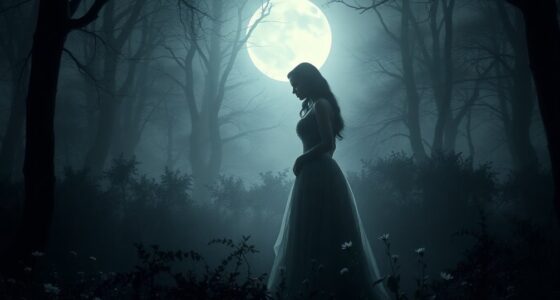Valentine’s Day started as ancient Roman festivals celebrating love and fertility, then blended with Christian stories like Saint Valentine’s sacrifice. Over time, courtship traditions, romantic symbols, and poetry shaped the holiday’s meaning. Today, commercialization and global customs add variety, while digital tools let you express love online. If you explore further, you’ll discover how modern celebrations keep evolving with heartfelt gestures and cultural influences around the world.
Key Takeaways
- Valentine’s Day originated from ancient Roman festivals like Lupercalia, blending pagan rituals with Christian stories of Saint Valentine.
- Medieval love poetry, symbols like roses and rings, and chivalric courtship shaped early romantic customs.
- The holiday became commercialized in the 1900s with mass-produced cards and gift-giving, expanding its global popularity.
- Cultural variations worldwide include unique traditions in Japan, South Korea, India, and Latin America, reflecting diverse expressions of love.
- The digital age has introduced virtual gifts, online celebrations, and social media sharing, transforming how love is expressed today.
Origins in Ancient Roman Festivals
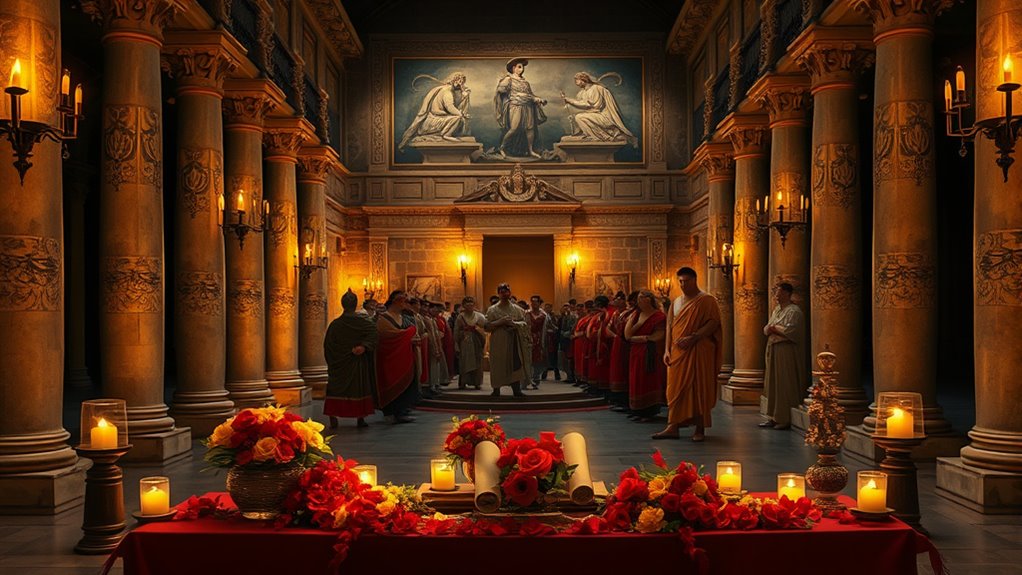
The origins of Valentine’s Day can be traced back to ancient Roman festivals that celebrated love and fertility. You might find it interesting that these festivals, like Lupercalia, involved rituals to promote health and fertile crops, as well as romantic connections. During Lupercalia, young men drew names of women from a box, forming pairs that sometimes led to romantic relationships. The festival was dedicated to Lupercus, the god of fertility, and was marked by feasting, sacrifices, and playful customs. Over time, these pagan traditions blended with Christian practices, gradually transforming into a holiday focused on romantic love. Interestingly, some of the romantic customs from these ancient celebrations, such as exchanging tokens of affection, have persisted into modern Valentine’s Day festivities. Though rooted in fertility rites, the festival’s joyful and affectionate spirit laid the groundwork for Valentine’s Day as we know it today.
The Influence of Saint Valentine
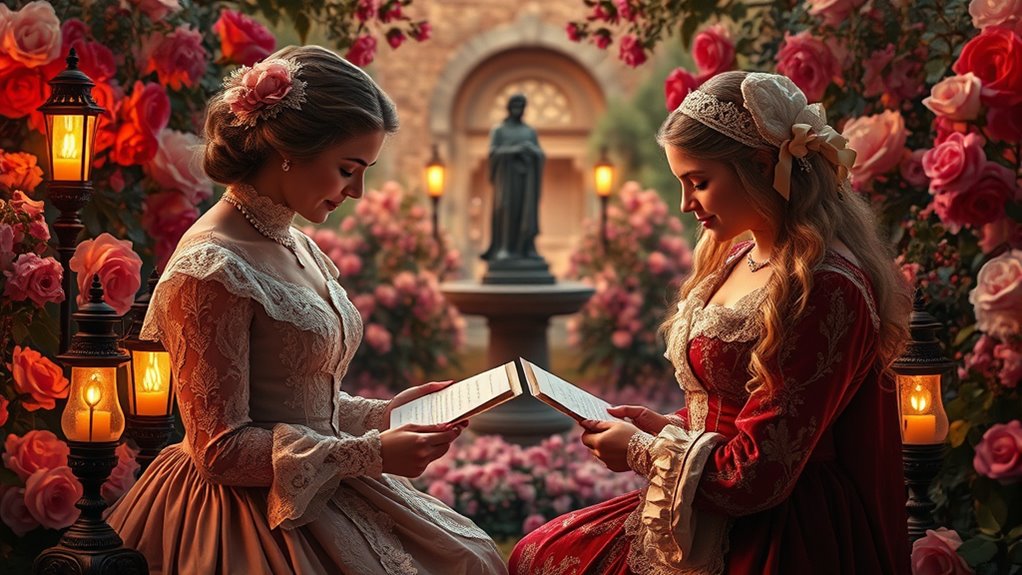
Although the origins of Valentine’s Day are rooted in ancient fertility rituals, the influence of Saint Valentine profoundly shaped its modern meaning. You might not realize it, but Saint Valentine’s story adds a layer of personal sacrifice and love to the holiday. Legend says he defied Emperor Claudius’s ban on marriages, secretly uniting couples in love. His act of compassion turned him into a symbol of devotion and romantic courage. Over time, his martyrdom transformed into a celebration of love’s enduring power. Today, Saint Valentine’s legacy influences how people express affection, emphasizing heartfelt gestures over rituals. His story reminds you that love often involves sacrifice, making the holiday more than just exchanging cards; it’s about honoring genuine connection and devotion. The history of Valentine’s Day also reflects evolving cultural practices, including traditional expressions of love through food and shared meals. These customs demonstrate how romantic traditions have been shaped by historical figures and societal values over centuries. Furthermore, understanding these cultural influences can deepen appreciation for the holiday’s significance across different societies.
Medieval Courtship and Romantic Traditions
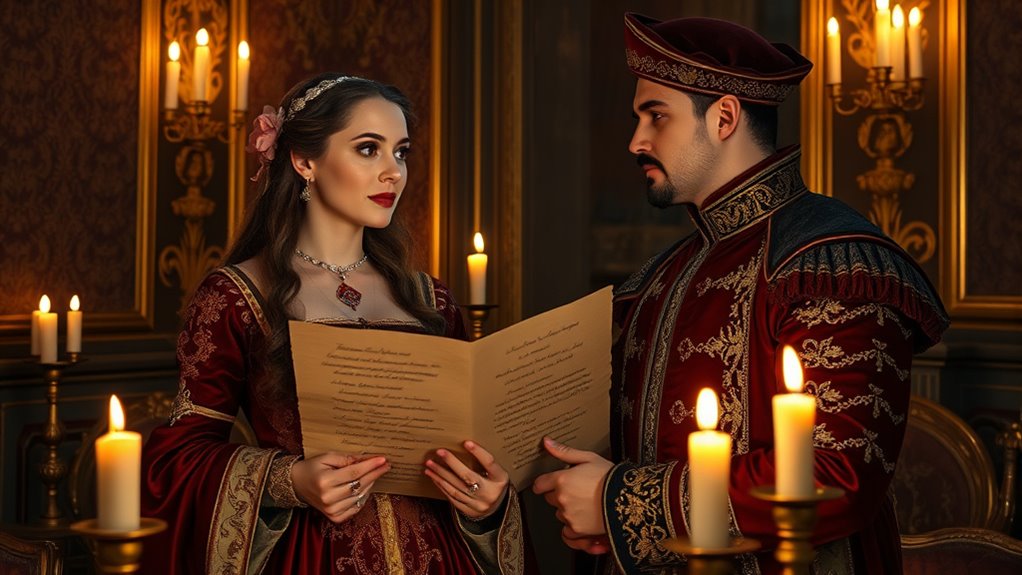
During the medieval period, chivalry shaped how lovers courted each other, emphasizing honor and noble gestures. Legends and romantic symbols, like love knots and roses, became important parts of courtship rituals. Literary works of the time also influenced how people expressed and idealized love, shaping romantic traditions we still recognize today. Additionally, the growth mindset reflects a modern approach to adapting and improving in various aspects of life, including romantic relationships. Modern romantic gestures often incorporate symbolic gifts, rooted in historical traditions, to convey affection and commitment. Furthermore, the process of a Gold IRA rollover highlights a modern form of financial transition, emphasizing the importance of careful planning and adherence to regulations in both romantic and financial realms. Embracing curiosity can lead to deeper understanding and connection in relationships, enriching romantic experiences. The development of vetted electric bike conversion kits demonstrates the importance of quality and reliability in evolving technologies, paralleling the careful consideration needed in romantic and financial decisions.
Chivalry and Courtship Rituals
In medieval times, chivalry shaped how knights and noblemen approached courtship, emphasizing honor, respect, and protective behavior toward women. Knights would perform acts of bravery and demonstrate their loyalty through rituals like gift-giving or participating in tournaments. Courtship often involved formal visits, written love notes, and the exchange of tokens symbolizing affection. These rituals reinforced social hierarchies and romantic ideals. To visualize, here’s a glimpse of medieval courtship:
| Activity | Purpose |
|---|---|
| Sending love tokens | Show devotion and intent |
| Participating in tournaments | Display bravery and valor |
| Writing love letters | Express feelings privately |
These customs laid the foundation for romantic traditions that evolved into modern Valentine’s Day celebrations. Incorporating romantic traditions from this era helped shape the customs we recognize today. Additionally, the social hierarchy played a significant role in determining appropriate courtship practices and expressions of love during this period. Recognizing the importance of courtship rituals provides insight into how these practices influenced contemporary romantic expressions. Understanding medieval courtship enhances appreciation for the historical roots of modern romantic gestures and celebrations. Moreover, the symbolism embedded in these rituals often carried deeper meanings, emphasizing sincerity and emotional connection.
Legends and Romantic Symbols
Legends and romantic symbols played a crucial role in medieval courtship, transforming acts of love into enduring stories and meaningful emblems. You might have heard of the legend of St. Valentine, whose sacrifice inspired romantic devotion. Symbols like hearts, roses, and rings became powerful tokens of affection, often carrying deeper meanings rooted in myth and tradition. During this era, lovers would exchange small gifts or write secret messages, turning personal feelings into legendary narratives. These symbols helped formalize romantic bonds, making love stories more engaging and memorable. Additionally, the use of romantic symbols in medieval celebrations laid the groundwork for modern Valentine’s Day traditions. The integration of cultural intelligence principles can further enhance our understanding of how these symbols fostered connection across different regions and traditions. Wisdom from ancient civilizations, such as the emphasis on truth and integrity, can also shed light on the authentic emotional expressions behind these romantic gestures. Incorporating historical context allows us to appreciate the enduring significance of these symbols in romantic history.
Literary Influences on Love
Literary works from the medieval period profoundly shaped how love and courtship were understood and practiced. These texts introduced ideals of chivalry, devotion, and poetic expression that influenced romantic relationships. You see, courtly love poems celebrated noble admiration and emotional connection, setting new standards for romantic pursuit. They encouraged you to see love as an art form, emphasizing sincerity and emotional depth. Additionally, these traditions often incorporated romantic rituals that reinforced social bonds and personal affection. The influence of these literary traditions fostered a cultural view of love that emphasized idealism and personal devotion. Furthermore, the emergence of literary symbolism helped deepen the emotional resonance of love stories and romantic poetry.
The Rise of Greeting Cards and Commercialism

As Valentine’s Day grew in popularity, greeting cards became a central way for you to express your feelings. In the early 1900s, companies began mass-producing cards, making it easy for you to send a thoughtful message without writing one yourself. These cards evolved from simple notes to elaborate designs with romantic imagery, catchy slogans, and heartfelt messages. Commercialism took hold as businesses promoted Valentine’s Day as an opportunity to buy gifts, flowers, chocolates, and cards, fueling a consumer-driven celebration. You might notice that the holiday shifted from a personal gesture to a major retail event, with companies capitalizing on your desire to show affection. This commercialization helped spread the holiday’s popularity worldwide, but it also changed how you perceive and celebrate love.
Modern Romantic Gestures and Celebrations
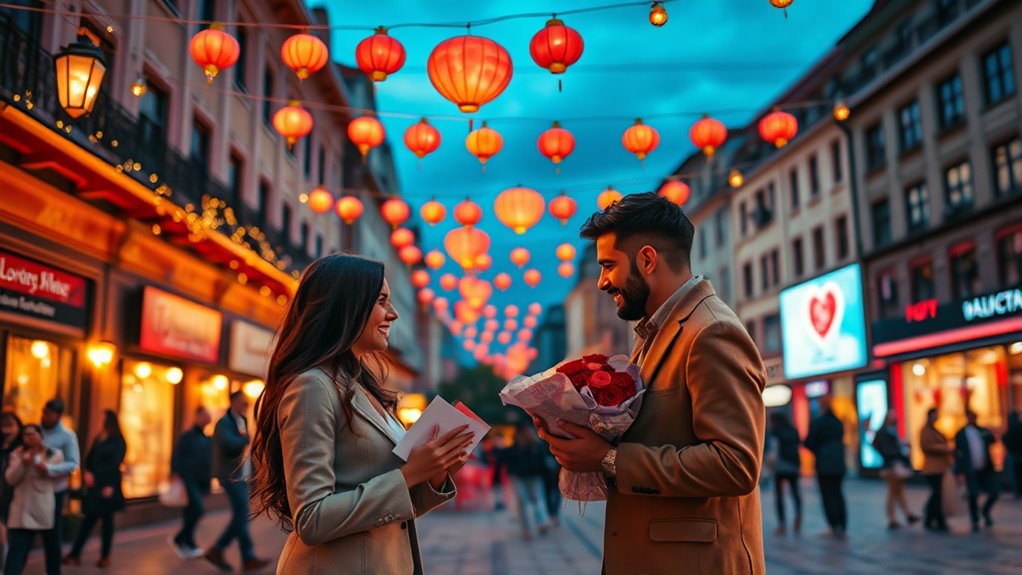
Today, couples are exploring new ways to celebrate their love beyond traditional gifts and cards. Instead of material presents, many focus on meaningful experiences that deepen their connection. You might plan a surprise getaway, cook a special dinner together, or spend the day doing something your partner loves. These gestures emphasize quality time and shared memories, fostering intimacy. Incorporating personalized skincare routines or thoughtful self-care gifts can also enhance the special day. Some modern romantic celebrations include: – Creating personalized experiences that reflect your partner’s passions – Writing heartfelt letters or messages to express genuine feelings – Engaging in activities that promote bonding, like outdoor adventures or creative projects. Using unique gifts that align with your partner’s interests can make the celebration even more memorable. These gestures remind you that love is about authentic connection and shared moments, not just tangible tokens. They help build a foundation of understanding and appreciation that lasts beyond Valentine’s Day, especially when couples embrace modern romantic gestures that emphasize emotional intimacy over materialism. Additionally, incorporating innovative celebration ideas can make the day even more special and personalized.
Cultural Variations Around the World

Around the world, Valentine’s Day takes on diverse forms shaped by cultural traditions and local customs. In Japan, women give chocolates to men, with a special day called White Day when men reciprocate. In South Korea, couples celebrate both Valentine’s Day and White Day, along with other unique days like Pepero Day, when people exchange snack sticks. In India, the holiday often blends with local festivals, emphasizing devotion and family bonds. In Finland and Estonia, Valentine’s Day is more about appreciating friends and loved ones broadly, rather than romantic partners. In Mexico, the day is celebrated with vibrant festivals, love songs, and community events. Each culture infuses the holiday with its unique values, making Valentine’s Day a reflection of diverse expressions of love worldwide.
Digital Age and Virtual Expressions of Love
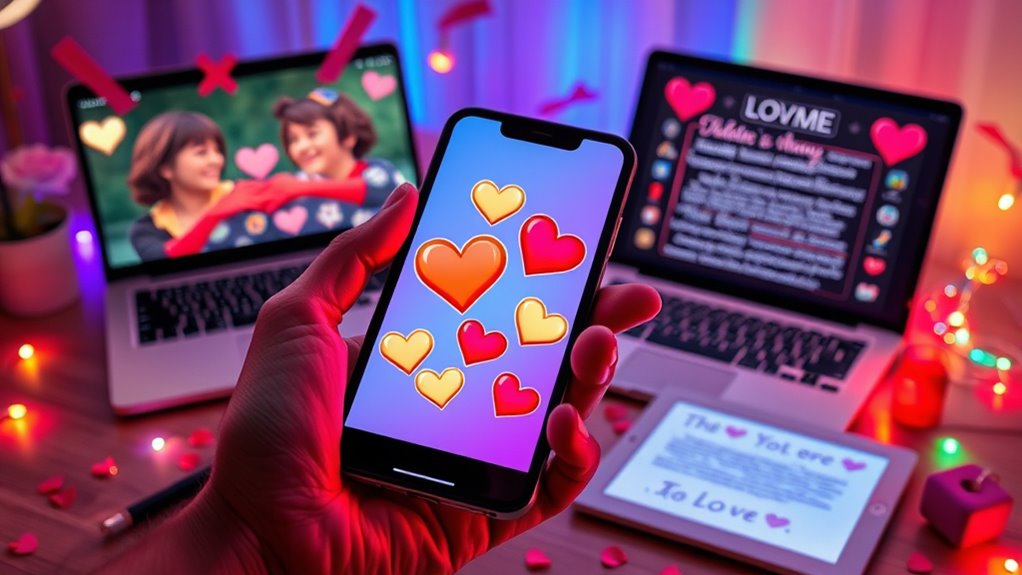
You can now send virtual gifts or share online romantic gestures to express your love instantly. These digital acts have become a popular way to celebrate Valentine’s Day, especially when physical distance keeps you apart. How do you think virtual expressions compare to traditional gifts and gestures?
Virtual Gift Giving
As technology advances, virtual gift giving has become a popular way for couples to express their love across distances. Instead of traditional presents, you can now send digital tokens that carry emotional significance. These gifts range from e-cards to personalized playlists or virtual experiences. They often symbolize thoughtfulness and effort, strengthening your connection despite physical separation.
Consider these deeper meanings behind virtual gifts:
- They show you’re thinking of your partner, even from afar
- They adapt to modern lifestyles, blending convenience with intimacy
- They foster creativity and personalization in expressing love
Virtual gifts remind you that love transcends physical boundaries and that meaningful gestures can be as impactful in digital form as in person. They keep the spirit of giving alive, regardless of distance.
Online Romantic Gestures
In the digital age, online romantic gestures have become a dynamic way to express love and affection beyond traditional boundaries. You can send heartfelt messages, share personalized videos, or create digital photo collages that capture special moments. Virtual date nights, where you and your partner dine together over video calls, have gained popularity, making long-distance relationships feel closer. Social media offers a platform to publicly celebrate your love through posts, stories, or online surprises. Sending e-cards or digital love notes adds a personal touch without physical distance. These virtual gestures allow you to stay connected, make your partner feel cherished, and celebrate love creatively, even when you’re miles apart. They reflect how technology transforms romance into an ongoing, interactive experience.
Future Trends in Valentine’s Day Celebrations
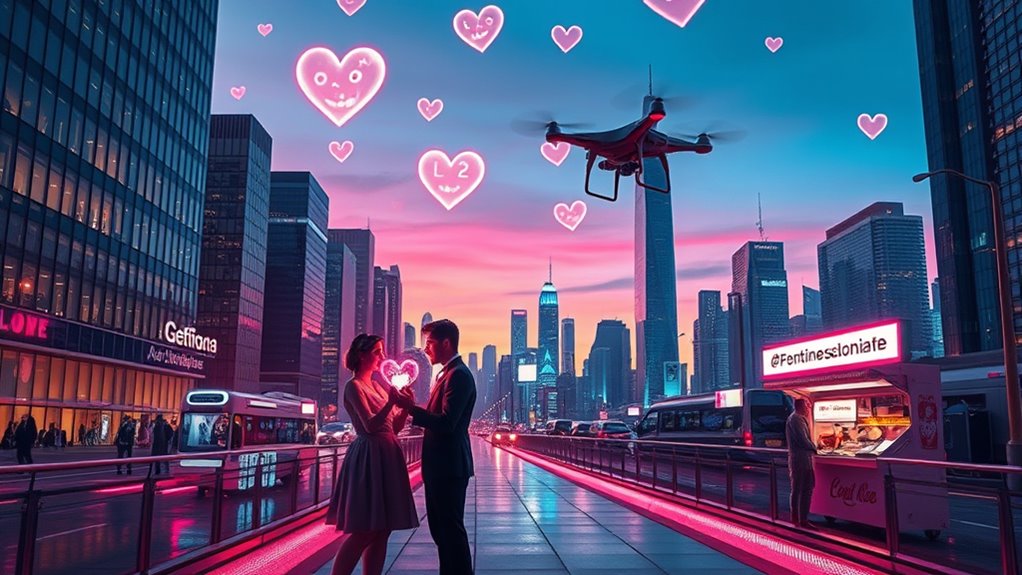
Looking ahead, Valentine’s Day celebrations are likely to become more personalized and tech-driven. You might see couples using virtual reality to share experiences or sending AI-generated love messages tailored to their relationship. Digital gifts will grow more sophisticated, blending convenience with intimacy. Expect innovations like augmented reality love notes or custom-made interactive experiences that deepen emotional connections.
- Personalized virtual experiences that mimic real-world dates
- AI-crafted messages and gifts that reflect your unique relationship
- Augmented reality interactions enhancing traditional gestures
These trends will make celebrating more meaningful and immersive, emphasizing your individual bond. As technology advances, your celebrations will blend creativity with intimacy, shaping a future where love feels more connected than ever.
Frequently Asked Questions
How Did Valentine’S Day Become Associated With Romantic Love?
You might wonder how Valentine’s Day became linked to romantic love. Historically, it started with ancient Roman traditions honoring Saint Valentine, a martyr. Over time, the day evolved, influenced by medieval romance and literature, especially Chaucer’s works. As people exchanged love notes and gifts, the focus shifted toward expressing romantic feelings. Today, you celebrate love through cards, chocolates, and dates, making Valentine’s Day a symbol of romantic affection worldwide.
What Are Some Unique Valentine’S Day Traditions Worldwide?
Did you know some countries celebrate Valentine’s Day in unexpected ways? In Japan, women give chocolates to men, while men reciprocate later. In South Korea, couples exchange love locks on bridges, symbolizing forever. In Finland, friends also share greetings, emphasizing friendship. These traditions show how unique cultural customs turn a simple day into a heartfelt celebration. You might find inspiration to create your own special way to honor love today.
How Has Social Media Changed Valentine’S Day Expressions?
Social media has transformed how you express love on Valentine’s Day. Instead of just private gestures, you can share heartfelt messages, photos, and videos with a wide audience instantly. It encourages you to be more creative and spontaneous, making love declarations more public and immediate. However, it also adds pressure to craft the perfect post, sometimes overshadowing genuine emotions. Overall, social media amplifies your Valentine’s Day expressions, making them more visible and impactful.
Are There Any Controversial or Lesser-Known Origins of Valentine’S Day?
You might find it surprising, but some lesser-known origins of Valentine’s Day involve ancient Roman festivals like Lupercalia, which celebrated fertility and love, often with rituals that seem quite different from today’s romantic gestures. There are also controversial stories about Saint Valentine himself, including legends of him secretly marrying couples against the emperor’s orders. These origins reveal that Valentine’s Day has complex roots rooted in both celebration and controversy.
What Future Innovations Might Influence Valentine’S Day Celebrations?
Like a painter with a blank canvas, you can expect future Valentine’s Day celebrations to be shaped by technology and sustainability. Virtual reality might let you share experiences across distances, while AI could personalize gifts and messages. Eco-friendly trends will likely grow, encouraging more sustainable practices. You’ll see more innovative ways to express love, blending tradition with modernity, making each celebration uniquely yours and more meaningful in a rapidly changing world.
Conclusion
As you embrace each year’s celebration, you become part of a timeless dance, where love’s delicate petals bloom in new, colorful ways. From ancient fires to digital whispers, your gestures paint a vibrant canvas of affection. While traditions shift like gentle waves, the core remains—your heartfelt expressions, like whispered secrets, continue to weave a story of connection that gently brightens every corner of your world.





